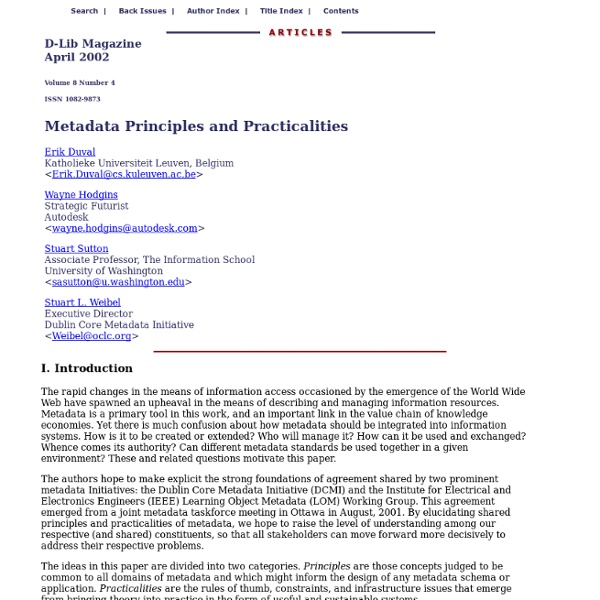Metadata Interoperability: A Study of Methodology
Metadata Interoperability: A Study of Methodology Lois Mai Chan, Ph.DProfessor, School of Library and Information Science University of Kentucky U.S.A. loischan@uky.edu ABSTRACT: The rapid growth of Internet resources and digital collections and libraries is accompanied by a proliferation of metadata schemas. Each metadata schema has been designed based on the requirements of the particular user community, intended users, type of materials, subject domain, the depth of description, etc. Introduction Recent decades have witnessed a proliferation of metadata schemas for description of digital resources. In recent literature, a great deal has been written about interoperability between and among different metadata schemas. Definition of Interoperability Many attempts have been to define the concept of interoperability. “The ability of multiple systems, using difference hardware and software platforms, data structures, and interfaces, to exchange and share data” (NISO 2004) Uniform Standard <?
Innkeeper at the Roach Motel
Show full item record Author(s) Salo, Dorothea Citation Salo, Dorothea. "Innkeeper at the Roach Motel." Date Dec 11, 2007 Subject(s) institutional repositories; open access Abstract Library-run institutional repositories face a crossroads: adapt or die. Permanent link Export Export to RefWorks Part of General Library Collection
That’s Capital: Funding, Resources and Influence | Introduction to Digital Humanities
The Link to My Prezi: One of the biggest issues facing the Digital Humanities field today is how to gather the resources needed to execute the ideas of the scholars and designers working in the field. This is not limited to financial resources, though those are important. Digital Humanists also need to gather time, people and social capital. Two of our readings this week- the second chapter of “Our Cultural Commonwealth” and “Innkeepers in a Roach Motel” by Dorothea Salo- deal with these issues. Six Challenges: “Our Cultural Commonwealth” points out six challenges facing the Digital Humanities. Ephemeral Data: basically this is referring to the fact that digital data is easily altered in a way that is untraceable. “Inn Keeper at a Roach Motel”: Institutional Repositories 1. Moving Forward: Salo gives 11 suggestions for what should happen with institutional repositories going forwards.
Library collaboration with large digital humanities projects
The sustainability of digital humanities research projects is a pressing issue for humanities computing. Currently, even well-established large digital projects like the Linguistic Atlas Project (LAP) are at future risk because funding and other resources are contingent on grant funding or faculty status of the director, neither of which will necessarily be available to maintain the project over time. The mission of the university library, however, includes archiving and dissemination, now increasingly of digital materials as well as traditional paper. Collaboration with the university library is the only realistic option for long-term sustainability of digital humanities projects in the current environment. © The Author 2010.
Anatomy of the national archive
Towards the Digital Library - Inside the British Library In the mid-1990s the British Library has undergone a most fundamental and transfiguring upheaval in the quarter century since its establishment under act of Parliament in 1972. It has also moved home, packing up 12 million of its books and periodicals, 39 million patents, two million maps and over a million sound recordings, and transporting them in 5,600 van trips from Bloomsbury and elsewhere to the Euston Road. Those seeking a gory postmortem of the protracted period of construction on the St Pancras site, or of the problematic process of fitting out and taking occupation of the new building, will need to turn elsewhere than Alan Day's latest book, Inside the British Library, the follow-up to his two earlier studies, The British Library: A Guide to its Structure, Publications, Collections and Services and The New British Library. His real focus is not the construction but the operation of the new British Library.
Metadata Interoperability and Standardization - A Study of Methodology Part I: Achieving Interoperability at the Schema Level
Abstract The rapid growth of Internet resources and digital collections has been accompanied by a proliferation of metadata schemas, each of which has been designed based on the requirements of particular user communities, intended users, types of materials, subject domains, project needs, etc. Problems arise when building large digital libraries or repositories with metadata records that were prepared according to diverse schemas. 1. In response to the rapid development of digital libraries and repositories, many general and domain-specific metadata standards have been developed or proposed by various user communities. In recent literature, a great deal has been written about achieving interoperability among different metadata schemas. 2. 2.1 Metadata Schema A metadata schema consists of a set of elements designed for a specific purpose, such as describing a particular type of information resource [NISO, 2004]. 2.2 Interoperability 3. Figure 1. 4. 4.1 Derivation Figure 2. Figure 3.
Book Review: The Visual Display of Quantitative Information – Edward Tufte
Book Review: The Visual Display of Quantitative Information – Edward Tufte Standard · Posted by qvdesign on April 13, 2012 · 2 Comments So here we have it; a book review of one of the two Qlikview recommended ‘must reads’ (the other being Stephen Few’s ‘Information Dashboard Design’ which I’ll cover at a later date), many of you will have already heard of the work of Edward Tufte so this review is perhaps aimed more at those new to Qlikview, Chart Design and Data Visualisation – although there is a crucial point for existing readers of this book at the end. First things first; who’s this book aimed at and suitable for? In short it should be read by anyone who has even a passing interest in Data Visualisation, this isn’t simply due to the ‘high level’ nature of the book but also the fact that it’s written in a very accessible style – very much unlike the more traditional ‘how to’ text books a la Mr Few’s. I do have to take a slight issue with some of the things he says however. Matt
Data visualization and digital humanities research



